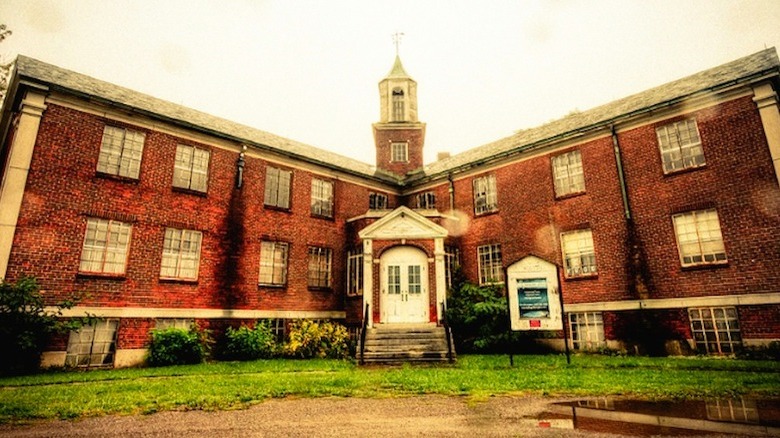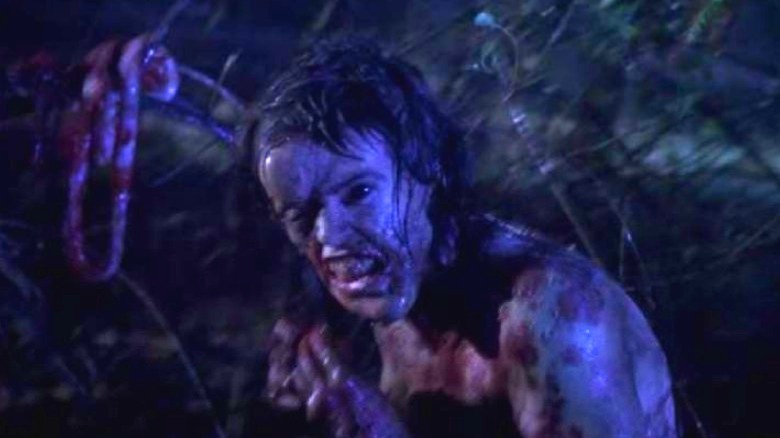Is The Asylum From American Horror Story A Real Place?
"American Horror Story" isn't your parents' horror anthology series. Instead of telling standalone, bite-sized tales of murder, monsters, and the macabre, each season revolves around many seemingly unrelated events that are actually linked in a blood-soaked timeline. Furthermore, while each season wears its long-standing horror trope inspirations on its sleeves, numerous elements are also based on the real world.
Throughout the show's history, many "American Horror Story" characters are based on real people, and several locations are likewise inspired by real places. One of the most obvious examples is Martin County, North Carolina, in the "Roanoke" season, a real county that sits on the bank of the Roanoke river. Another (more important) example is Briarcliff Manor in "Asylum." The manor has been converted into a makeshift asylum, even though it is ill-kempt and run-down, and it comes across as your quintessential haunted asylum — although the horrors lurking inside are much worse.
Given the number of asylums purportedly haunted by the ghosts of the damned, you might wonder if Briarcliff Manor draws from the trope of haunted asylums in general or from one in particular. The answer is both.
Rolling Hills is a spiritual hotbed
It's no secret that mental asylums have a very bad rap. Before modern mental health care reforms, many institutions were overcrowded, gave patients no help or supervision, and weren't care facilities as much as they were dumping grounds. Many patients endured barbaric conditions and the occasional inhumane experiment. To give audiences an early, controlled taste of these conditions, the people behind the show teamed up with an actual (and possibly haunted) ex-asylum for an "AHS" promotion.
Before "Asylum" hit airwaves, FX offered a "Get Committed" promotion, where lucky winners could spend some time in "the American Horror Story asylum," but in reality, they visited the Rolling Hills Asylum. Even though the Rolling Hills location isn't home to the same kinds of evils housed in the fictional Briarcliff Manor, the building is very spiritually active, according to the asylum's website. Many people have reported seeing and hearing ghosts inside Rolling Hills, and what better way to promote a fictional ghost story than letting potential audiences meet "real" spirits?
Aside from the promotion, Briarcliff Manor is not related to the Rolling Hills Asylum in any way. The Manor isn't built like the asylum, and the show wasn't shot inside it, either.
Asylum may be inspired by true experiments
If you research Briarcliff Manor, you will find that it, too, actually exists. Not only does the manor provide an excellent venue for weddings, but it also includes catering. In all seriousness, though, you can thank your lucky stars there is no real Briarcliff Manor asylum as depicted on "AHS." However, that doesn't mean the location and its experiments are purely works of fiction.
In "American Horror Story: Asylum," Briarcliff Manor's resident physician, Dr. Arthur Arden/Hans Grüper (James Cromwell), transforms patients into disfigured abominations that are more resilient to pain and radiation, similar to his actions in concentration camps. While no actual American asylums were used as testing grounds for renegade Nazi scientists, Arden/Grüper's experiments are eerily similar to those carried out in Willowbrook State School.
Willowbrook, which was called a "snake pit" by New York Senator Robert Kennedy, was home to one of the most horrific experiments conducted on American soil: Doctors intentionally infected patients with hepatitis to study the disease. It gets worse, because if test subjects weren't injected with the virus, they were forced to eat the feces of those already infected. These experiments persisted from the 1950s until the 1970s, when Geraldo Rivera blew the lid off Willowbrook. Even if "Asylum" has no geographic basis in reality, the truth is sometimes more terrifying than anything we could see on the show.


